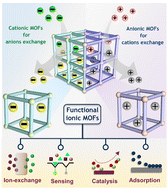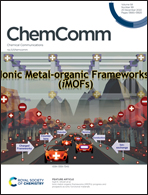Ionic metal–organic frameworks (iMOFs): progress and prospects as ionic functional materials
Abstract
Metal–organic frameworks (MOFs) have been a research hotspot for the last two decades, witnessing an extraordinary upsurge across various domains in materials chemistry. Ionic MOFs (both anionic and cationic MOFs) have emerged as next-generation ionic functional materials and are an important subclass of MOFs owing to their ability to generate strong electrostatic interactions between their charged framework and guest molecules. Furthermore, the presence of extra-framework counter-ions in their confined nanospaces can serve as additional functionality in these materials, which endows them a significant advantage in specific host–guest interactions and ion-exchange-based applications. In the present review, we summarize the progress and future prospects of iMOFs both in terms of fundamental developments and potential applications. Furthermore, the design principles of ionic MOFs and their state-of-the-art ion exchange performances are discussed in detail and the future perspectives of these promising ionic materials are proposed.

- This article is part of the themed collection: Emerging Trends in MOFs


 Please wait while we load your content...
Please wait while we load your content...